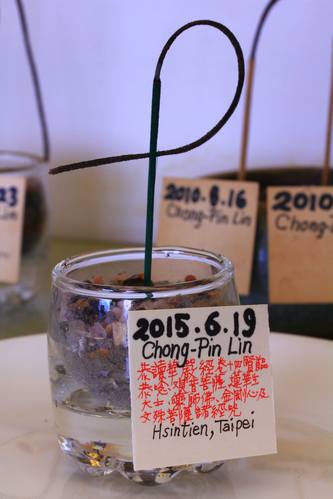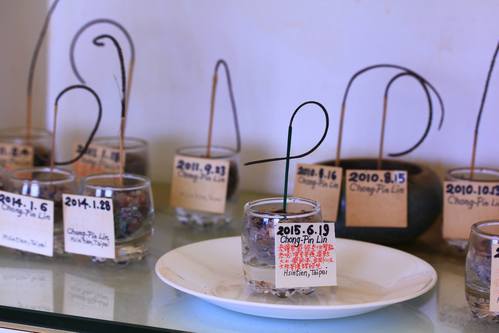June 19, 2015
accessed June 26, 2015



今晨4:30起床,4:50讀華嚴經卷十四賢首品十二之一。賢首菩薩回答文殊菩薩之偈中不斷提到 "三昧"。其意為"止息雜念使心神平靜"。剛好昨日讀紐約時報報導 :印度總理莫迪將於6月21日星期日早晨7時號召3萬5千政府官員、學生、公民在德里舉行集體瑜珈活動,要打破世界紀錄。同時提到莫迪每天做瑜珈並進入"三昧"。去年秋天訪美忙碌的9日行程,他遵照瑜珈規定絕食。此舉令歐巴馬著實佩服莫迪的精力過人。自5:00至6:00,依此心念誦經咒及靜坐,並見此香花。
I was up at 4:30 this morning,read "Huayan Sutra" from 4:50 - 5:00,and from 5:00 - 6:00 recite mantras,sutras , prayed and meditated to find the incense flower appearing. I was thinking of what Huayan Sutra mentioned: samadhi which I read yesterday in a New York Times article about Indian prime minister practicing yoga daily to attain the "samadhi". Modi is calling for a 35,000 mass yoda exercise at 7am Sunday June 21. He maintained his fast during a busy 9-day visit in the U.S. last fall and really impressed with his abundant energy U.S. president Obama .
林中斌 2015.6.19




Modi’s Yoga Day Grips India, and ‘Om’ Meets ‘Ouch!’
http://www.nytimes.com/2015/06/16/world/asia/india-modi-yoga.html?_r=0
NEW DELHI — On a sticky morning last week, Deputy Commissioner Chandra Shekhar Sahukar of India’s Agriculture Ministry (animal husbandry department, small ruminant section) found himself in a yoga class for the first time in his 57 years, miserably grasping his ankle.
In his bag he carried a photocopy of a memorandum advising senior officials to familiarize themselves with certain postures ahead of International Yoga Day this Sunday, when they will take part in a mass outdoor yoga session scheduled to begin at 7 a.m. The session is intended to qualify for the Guinness Book of World Records, the memo says, warning, “If some officials turn up without practice, there will be risk of the record claim being affected.”
At the front of the room, the instructor was folding and unfolding himself like a pocketknife, and pointedly reminding members of the class that they would soon be performing under the scrutiny of “Modi-saab.” When he asked the students to press their faces to their knees, Mr. Sahukar — whose professional duties, he noted later, include “a lot of sitting” — could keep silent no longer.
People, including some government employees, practicing yoga in a class in Delhi, India. Credit Kuni Takahashi for The New York Times
“It’s not touching!” he exclaimed. “I can’t bend anymore!”
Of the major initiatives that Prime Minister Narendra Modi has introduced since taking office, few have generated as much static as Yoga Day, which will feature a 35-minute public demonstration of poses by more than 35,000 government employees, students and other citizens. Though the Western world regards yoga primarily as physical exercise, Indians are more apt to see its postures and Sanskrit chants as freighted with ideological or religious meaning.
Preparations for the event set off a chorus of criticism, mostly from a handful of Muslim activist groups that say they should not be compelled to chant “Om,” a sound sacred in Hinduism, or perform the sun salutation, which they say violates the monotheistic nature of Islam.
Mr. Modi’s officials have hurried to address those complaints, assuring the public that participation in Yoga Day is optional and that it focuses exclusively on health, not religion. “Om” is not part of the Yoga Day protocol, nor is the sun salutation. The debate so incensed one right-wing member of Parliament that he suggested that those displeased by the sun salutation “drown in the sea.”
Behind the headlines, there is little doubt that the yoga campaign amounts to a cultural challenge, in a capital city powerfully shaped by its British and Mughal past. New Delhi’s elites are mostly Anglophiles, fond of their whisky and butter chicken; its clerks spend their days in dim warrens of paper files, tensed against the next supervisory tongue-lashing. Many rank-and-file civil servants have bellies like first-floor balconies.
Shripad Naik, India’s first minister overseeing yoga and traditional medicine, who has helped organize this month’s celebration, said it was time to clear away the vestiges of a Western lifestyle left behind by colonial powers.
“Earlier, our people used to get up before sunrise and sleep before sunset, but now our lifestyle has changed. They are going to the pub, they will go in the middle of the night, at 12 or 1, and eat chicken and many, many new dishes,” said Mr. Naik, who, like the prime minister, rises before dawn and practices yoga daily. He recommends going to sleep by 9 p.m., gets his news from the Hindi-language press and proudly declares that he has never had an injection.
“There will be a lifestyle change,” he said. “Our style will come.”
Mr. Modi is not the first Indian leader to promote yoga. Indira Gandhi was so devoted to her yoga instructor, Dhirendra Brahmachari, that he accompanied her family when it traveled and became known as the “flying guru.” In the late 1970s, Mr. Brahmachari hosted a weekly television show, and yoga was included in some school curriculums. But after Mrs. Gandhi’s assassination in 1984, his influence waned, and he withdrew behind the walls of his ashram.
Mr. Modi has no guru of that importance, but since the 1980s, he has consulted regularly with H. R. Nagendra, a Bangalore guru who focuses his practice on achieving samadhi, a state of profound meditative absorption. Mr. Nagendra said Mr. Modi drew from the thinking of various popular teachers, including the gurus Baba Ramdev, Sri Sri Ravi Shankar, Jaggi Vasudev and Mata Amritanandamay.
The strains of yoga arising now are, in many cases, intermingled with Hindu nationalist thought. Sun salutations and Sanskrit chants are part of the daily, military-style drills of the Rashtriya Swayamsevak Sangh, the right-wing Hindu group that started Mr. Modi on his political career. The daily shakhas, as the drills are known, were designed to “create an all-Bharat national consciousness.” Bharat is the Hindi name for India.
Shripad Naik, India's first minister overseeing yoga and traditional medicine, practicing yoga in the garden at his residence. Credit Kuni Takahashi for The New York Times
Mr. Nagendra, the nephew of a prominent R.S.S. leader, says his techniques have sent cancer into remission in 350 cases, weaned thousands of asthma patients off medications and treated psychiatric disorders, as well as homosexuality.
“It is the extreme stress that takes place, the stressful life, the wrong lifestyle, which makes them go for homosexuality,” he said. “We work to reduce the craving at the deeper levels. Once you do that, your desire to have sex or excessive sexual indulgence is gone.”
At events, Mr. Modi often shares the dais with Baba Ramdev, who presides over an ayurvedic medical empire and has preached against influences he describes as foreign, among them the English language, chemical pesticides and fertilizers. Mr. Naik, the yoga minister, himself learned yoga through the R.S.S., and he said he hoped that the widespread practice of yoga would lower rates of violent crime.
“You see these rapes happening, all these bad habits, he said. “When he is doing something positive, the bad will be out of him.”
As for government workers, Mr. Naik said, they will become more productive and less corrupt. “There will be a definite change in the way the bureaucracy functions,” he said. “When they are thin, all their energy will go into producing better work. There is no need to do it forcefully, once we have put them on the right path.”
Last week, that process seemed likely to be a long one. At the morning session recommended for bureaucrats, the instructor issued a series of staccato commands: “Touch the nose to the toes! Open the knees! Don’t raise your buttock! Stick the buttock to the floor! Stick the buttock to the floor!” His students assumed expressions of intense concentration, apparently focused on not tipping over.
Kuldip Kumar, 38, a clerk in the administration of All-India Radio, gave a little smirk when asked why he had attended the practice session, his first in 25 years.
“There is a stick hanging over all of us,” he said. “When the prime minister comes, if officials do not show up, of course it is bad for their career. The attitude is, we have to beat them with a stick to get the job done.”
Others, filing out, said they had been inspired by the asceticism of Mr. Modi, who kept to a nine-day religious fast throughout a jam-packed visit to the United States last fall. (“Even Obama had to bow down when he saw Modi so energetic,” one of them said.)
Shiv Visvanathan, a sociology professor, said many of Mr. Modi’s most prominent initiatives as prime minister, like the national cleanup campaign, known as “Swachh Bharat Abhiyan,” involved asking citizens to look within themselves and change their habits.
“He is looking for a new kind of cultural revolution,” Dr. Visvanathan said. “I like the comic part of it — the fat cops, the bureaucrats, doing exercise. Here is India, getting fat on hamburgers and milkshakes. Modi is the Benjamin Franklin of India in many ways.”
Bal Mukund Singh, the yoga instructor, ended the class by urging his students to become Hanuman, the monkey god, and then watched as they dispersed to the offices where they would spend their days handling dusty file folders and eating fritters. When they were out of sight, he checked off the characteristics he had observed, things like “big tummy, rigid body, less flexibility, stress, tension, depression, diabetes.” Still, he said cheerfully, these are good days.
“They heard it on TV, and they are running toward the yoga,” he said. “The prime minister is the king. If the king does something, that is very effective. And this time, our king is doing yoga.”


 留言列表
留言列表


